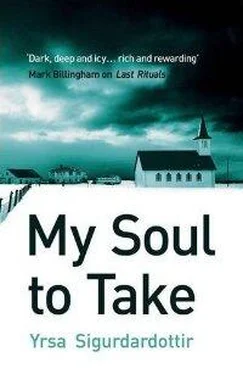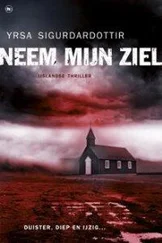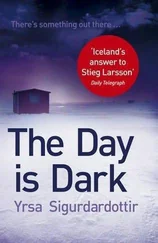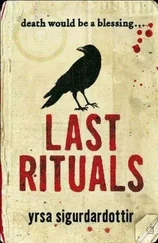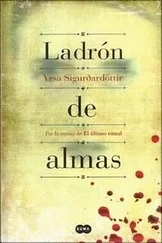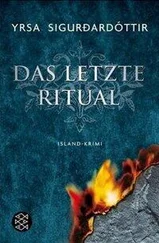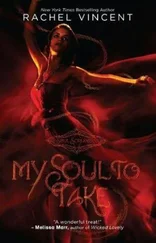On the top of the box lay a folded Nazi flag. The white field around the black swastika had turned slightly yellow, and the material was rough to the touch. Thóra frowned as she carefully removed it and put it to one side. Perhaps the swastika in Birna’s diary had not been a mindless doodle after all. Beneath the flag was a pile of magazines, the uppermost one even more faded than the flag. The magazine was called Iceland, and a Nazi emblem was centered under the title. Jónas had not mentioned this in his cryptic account of ghosts and the house’s murky history. Thóra picked up the magazine and saw that the others in the pile were the same. They were published by the Icelandic Nationalist Party. Thóra shook her head. She knew there had been a small Nazi movement in Iceland before the war, but couldn’t remember much about it. It had clearly been involved in publishing, although the magazines were thin and not big on content, judging from the headlines.
Leafing through the pile, she also noticed several issues of a student newspaper called Mjölnir, whose publisher, according to the masthead, was the Nationalist Students’ Association. Thóra removed the pile of magazines from the box to see what was concealed underneath and found a folded shirt, a swastika armband, and what appeared to be a military belt with a shoulder strap attached. How could anybody be into this?
By now Thóra was close to the bottom of the box and she noticed a brass object, which when she picked it up turned out to be yet another swastika. Its base was a kind of socket, whose purpose, if any, was unclear. There were also various scraps of paper advertising dances, camping trips, and meetings that the nationalists had apparently organized, along with items of no political significance, such as an old wallet, shoes, and photographs of people who did not seem to be wearing swastikas. There were no children in the photographs, but they shared a common theme: smartly dressed people in the prime of life, either sitting on blankets as if picnicking or posing against the wall of a house. Although the same wall featured in more than one of the photographs, not enough of it was visible for Thóra to make out whether it belonged to the old farmhouse upstairs. Judging from the outfits, the photographs were taken during the war and just afterward.
Thóra tried to replace the objects in the box in the right order, although the box looked like it hadn’t been opened for ages, so there was little chance of the person who had packed it noticing the difference. It just seemed better to leave it as she had found it. There was little to pique her curiosity in the next box that Thóra looked at. It mostly contained finely crocheted tablecloths, quite old, and an old-fashioned floral-patterned vase with a gold trim. The third box contained an aged photograph album. Thóra’s grandmother had owned a similar album, and she suddenly felt sad as it struck her how short life was and how quickly we were forgotten. It would be difficult, now, to find someone who recognized the people in the album. Soon it would be impossible. She sat down on one of the boxes to browse through the photographs.
She lifted the thick cover. On the first page, under a flysheet that looked like carbon paper, were some snaps taken by the old farm-house. The building, which looked almost new, was virtually unchanged, and a carved wooden sign above the entrance read KIRKJUSTÉTT. Thóra carefully unhooked the photograph from the corner mounts. On the back was a stamp showing that the photograph had been taken, or developed, in 1919. In delicate handwriting, which must have been female, was the inscription “Bjarni Thórólfsson and Adalheidur Jónsdóttir.” Examining the photograph more closely, Thóra deduced that the photographer must have had his back to the sun, because the couple were trying their best not to squint to keep the sun out of their eyes. They were a handsome couple; he was tall with thick bushy hair falling in a quiff over his forehead, and she young and wearing a calf-length skirt, smart flat shoes, and an old-fashioned hat that fitted tightly to her head. Blond hair gleamed beneath it. He was dressed in light, baggy trousers with a pronounced crease, and a shirt and braces. They were standing beside each other by the front wall, their hands by their sides. Old-style proud homeowners.
On the same page was another photograph with the same subject, featuring these two with another couple. Thóra carefully remounted the first photo and took out the second. In the same handwriting, it said that the second couple were called Grímur Thórólfsson and Kristrún Valgeirsdóttir. Even without the shared surname, it was obvious that Bjarni and Grímur were brothers. Their clothing was very similar, but in different colors. She scrutinized the picture but could read nothing from their expressions as they grimaced into the sun. She could see that the woman who must be Grímur’s wife was very different from the fair-haired Adalheidur. She was older and more buxom, stouter and less smartly dressed, in a plain skirt, thick sweater, and heavy flat shoes. Her dark hair was tied back in no particular style. Thóra wondered how these two very different women would have got on together. She turned the page.
On the next pages were three photographs of the young Bjarni and Adalheidur, all taken outdoors. They had not changed much from the previous shots, except that the young woman was no longer wearing a hat. Thóra kept going and examined two more pictures in which the elder brother and his wife again joined the younger couple, along with a little dark-haired girl, a chubby, bonny baby dressed in the fashion of that time. Looking at the back of the photograph, Thóra saw that the girl was named Edda Grímsdóttir, so she must be the daughter of the elder brother, Grímur. It was taken in 1922, and the girl looked about a year old. The following pictures were taken at intervals of several years. In one of them, dated 1923, Thóra thought Adalheidur, the younger woman, looked pregnant, but there was no sign of another baby in the photographs that followed—not until she chanced upon one from 1924, taken at a studio and showing the young couple holding a baby, several months old. The child was swaddled in a mass of frills, and on the back of the photograph she was identified as a girl by the name of Gudný.
Another picture of the first girl followed, but an extremely peculiar one. She seemed to be sleeping, wearing a crocheted frilly cap that barely covered her head, and a white frilly dress, but her body was in a very strange position. Neither of Thóra’s children had ever slept like that, with their arms crossed over the chest and legs stretched out straight. Thóra removed the photograph to read the back. The girl’s name, Edda Grímsdóttir, was written there, then two dates with a cross drawn in front of the latter one. She had died the same year that Bjarni and Adalheidur had been blessed with their little girl. Thóra put it back in the album and sighed heavily. She knew that it had been a custom at that time to take pictures of the dead, but she had never seen such a photograph, let alone held one. She wondered if this was the photograph Jónas meant when he said he had seen one showing the ghost. All ghosts were born from sad or unjust circumstances and the death of this young infant must have been one if not both.
Thóra felt she was just beginning to get to know the people from the farm as she flicked through the remaining pages. This imaginary familiarity left her saddened, as she saw how time had taken its toll on the family. There were no photographs of the elder brother after 1925, for example. It was as if he and his wife had moved away or otherwise disappeared from the young couple’s lives. Perhaps the loss of their daughter, Edda, made them abandon their farm. Adalheidur also vanished from the photographs after 1927. The last shot of her, in which she was obviously pregnant, was dated 1926. The penmanship also changed that year, becoming rougher, and it did not take a handwriting expert to see that it was male. Thóra felt she could see grief on Bjarni’s face from then on. Yet he still smiled sincerely at little Gudný, who judging from the photographs grew and blossomed, beautiful like her mother but also uncannily like her father’s side of the family.
Читать дальше
